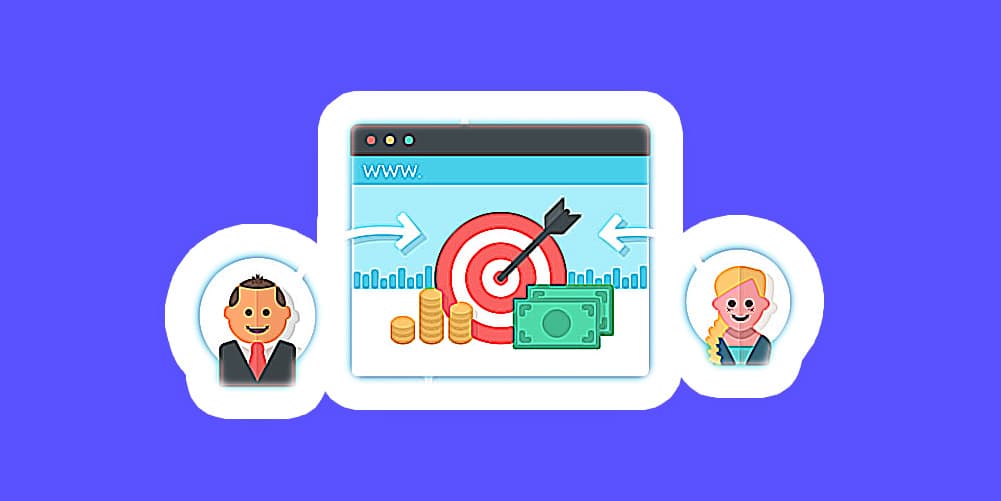
How to Get More Clients on Upwork
Upwork is an amazing platform for freelancers and small agencies to get more clients.
But how do you land said clients?
Picture this: you've created a faultless profile, sent dozens of cover letters...
...yet your Upwork Connects are running out at an alarming rate, and there is no new project to take on.
Well, I've been there. But after a few months using the platform, I learned what makes prospective customers "tick", and slowly started landing more gigs.
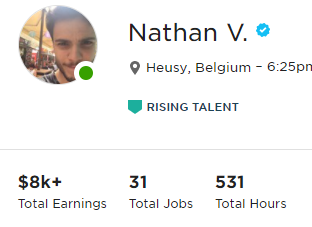
After 30 jobs and over $8,000 in earnings, I believe it's a good time to teach others how to get more clients on Upwork.
Let's dive right into it!
No time to read the whole post? Download our anatomy of a perfect Upwork cover letter PDF and start landing more clients today.
1. Craft a flawless Upwork profile
Your Upwork profile should have one goal: to make your prospective client go, "that's the person I need for this job".
When you create your account for the first time, Upwork will try to help you complete it by adding your portfolio, profile picture, description, employment history, etc. Take your time to complete it to reach a score of 100%.
There are three specific parts of your profile you should spend extra time optimizing: your tagline, your skills, and your portfolio.
Why? Because they are going to be at the forefront of any Upwork job application:
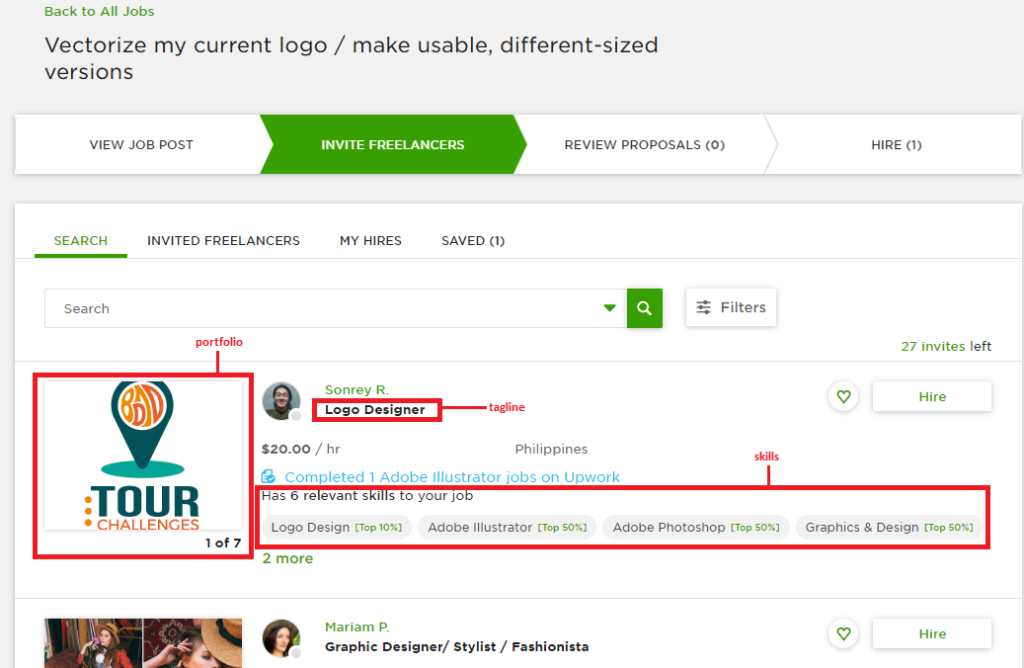
Let's have a look at how you can optimize them to land more clients:
- Tagline: there's no need to be fancy or super creative. Do you intend to apply to Graphic
Design jobs? "Graphic Designer" is completely fine.
Here's an example of taglines that don't work that well:
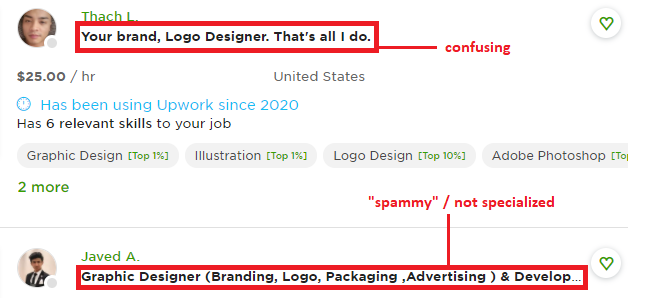
Fun fact: my tagline used to be something like "Better translations = better communication". I changed it to "English & German to French translator" and immediately started landing more clients!
- Skills: skills will automatically be selected by the Upwork algorithm to sort profiles by
relevancy. Don't leave this part out when you optimize your profile!
- Portfolio: especially important if you work in a creative industry. Make it eye-catching and pick your best work.
A good way to craft a good profile is simply to look at the top profiles in your industry, and figuring out what they are doing right.
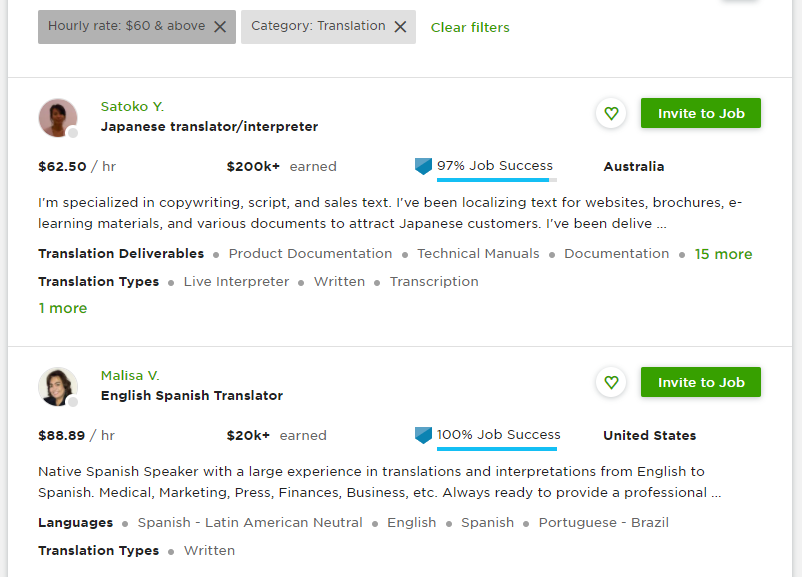
You can do this by creating a Client account on Upwork.
Once logged in, head over to the "Talent" menu, and sort by industry, hourly rate, location, etc.—until you find a profile that inspires you.
2. Specialize
When you design your profile, you might have to make some tough decisions.
What if, for example, your main business is translation, but you find yourself taking on a lot of SEO projects on the side?
Or maybe you're a graphic designer who happens to also build NodeJS apps from time to time.
So which one do you choose? Which projects should you apply to in priority?
My advice is: don't apply to every single project out there.
If your tagline states "Graphic Designer", all of your recent projects have been about graphic design, and you want to apply for, say, a translation gig—you might end up wasting connects if the job poster believes you aren't qualified for the job.
With that said, a good cover letter might help convince your potential client otherwise.

3. Speed is of the essence
Competition is rough, and competition is plenty. Worst of all, competition is fast:

The screenshot above is for an e-commerce site speed optimization gig. It was posted just a few minutes ago, yet the client is already interviewing 3 potential freelancers.
It's safe to say that I missed the boat here. As a matter of fact, there's only ever been a few projects where I applied late and ended up landing the client.
I believe this to be in the nature of Upwork: the platform favors one-off, quick & easy jobs ("create a logo", "translate this document", "migrate our new server", etc.) rather than full-time hires.
Clients therefore tend to interview and hire fairly quickly.
My rule of thumb for dealing with this is to only apply to jobs that have been posted within the last 4 hours, maximum, and if no interview is going on yet—as this means that our prospective customer is probably still looking for the perfect fit (you)!
4. Choose your clients
Some clients are more likely to hire you than others.
Once again, the idea is not to just apply to each and every single Upwork opportunity.
Here's a few checks I go through every time I think of applying for a job:
Check #1: Client budget
Does the client's budget meet your expectations?
If your average hourly salary is $25.00/hour, then applying for low-budget jobs will be a waste of time (and connects!) for both you and the potential client.
There's four places to inspect here:

- Hourly budget: the client's estimate of your time's worth. Sometimes negotiable, sometimes not, but it gives you an "in-the-ballpark" idea of the client's budget.
- Freelancer level: if the client picks "Entry level", you can probably skip the job posting
altogether (unless you are new to Upwork)—they are most likely looking for the cheapest provider.
The "intermediate" and "expert" level options have wildly different interpretations. I've had quotes for "intermediate level" jobs at $500 and "expert level" for $50. Still, it gives you an idea of how much the client is willing to spend.
- Total spent and average hourly rate paid: I've found those to be much better indicators of the
client's budget: how much have they spent in the past?
If they've hired a NodeJS developer for $15.00/hour but you'd rather price your services at $50.00/hour—it might be a wise use of your time to skip this client.
Check #2: Client reviews and hire rate
The great thing about Upwork is that clients are rated just as much as freelancers.
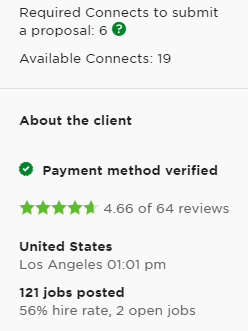
The second section I check is the client's reviews (as long as they have 4 stars, all is good) and their hire rate.
The amount of jobs that get posted, then abandoned, is actually quite high: on the picture above, for example, the client has a 56% hire rate only.
That means there's a good chance they will not hire anyone for the job you're applying to!
Check #3: Job description and questions
My final check is the job description itself—and questions the client might have (those are optional).
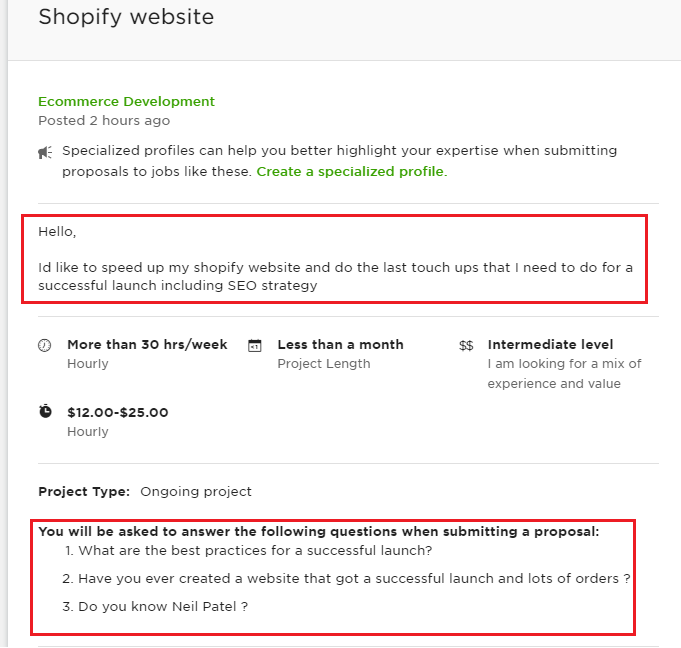
My first worry, obviously, is to make sure that I'm the right fit for the job.
More importantly, however, the description and questions help me understand exactly what the client hopes to achieve.
This is your chance to gather a lot of bonus points—and tailor your job application to the client.
If I get the idea that I'm perfect for the gig, and I could write an amazing cover letter that would land me the job for sure—I'll go for it.
This brings us to my next point:
5. Write an amazing cover letter
A lot of freelancers tend to hate this part.
Let's go back to my Upwork client account to have a look at what you should not do.
This job posting's title was "Help me set up a subdomain on VPS [nginx]".
Here's a cover letter from one of the applicants...
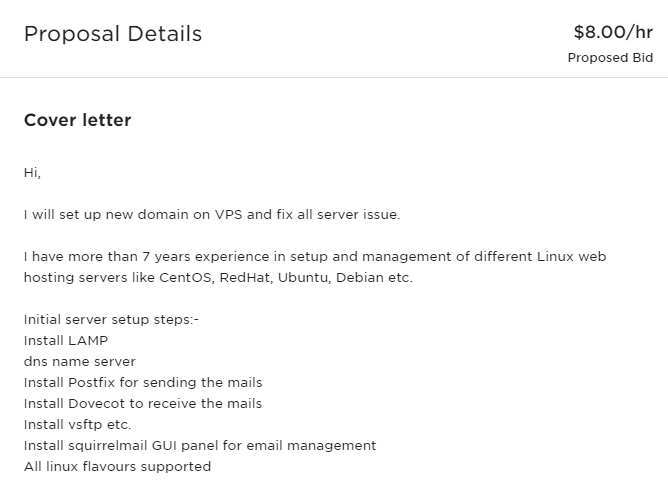
First off, I don't understand about half the things on this list.
Second—of those I understand, it's completely irrelevant to my job posting.
Lazily copying and pasting your Upwork profile is not the way to go about this.
Here's what you should do instead: customize.
This goes back to what I was talking about in the previous steps. You want to be relevant and customize your message as much as possible: make the customer feel like you understand his specific project and that you're the person for the job.
Go back and read the job description carefully. Customer stated his name, or his company name? Use it in your cover letter.
Does the client have specific questions that'd help you demonstrate your expertise on the subject? Take some of your time to answer them thoroughly.
Does the client happen to be from the same country or speaks the same language as you? Mention it too—I've found this to work particularly well for me.
If you manage to make the client feel like you're directly addressing him and his concerns, you're doing better than 90% of freelancers out there already.
I'll finish this section with a quick analysis of one of my most recent cover letters.
Step #1: greet the prospect, with his name or company name if possible.
Hey there,
Step #2: tell your potential client why you decided to apply, and immediately position yourself as the right person for the job.
I usually do translation jobs on Upwork, but I thought I'd apply to this job considering my extensive experience in the field.
Step #3: make it clear that this is not your first rodeo, and address typical concerns ("will my PageSpeed score go up?" / "will this change anything to my user experience?").
I have been working on several page speed projects (for Shopify) in the last few months, and it's being going really well. I've brought PageSpeed scores from 50 to 80, and from 3 to 50 with minimal changes to user experience.
Step #4: explain to your potential client the way you're going to work, with clear, detailed steps if possible. I have a 3,000+ words blog post on this specific issue, which makes things a little easier for me!
It's been going so well that I wrote an article about it:
[link was redacted for this post].The blog post will give you an overview of the way I work and what changes I would
do to your website.
Fixing a Shopify site's speed typically comes down to identifying the apps and scripts
that cause the most trouble with your load time and trying to find an alternative for them, or making sure they only
load where needed. Besides that—it's all simple image & script optimization tasks :)
Let me know if
you're interested!
Nathan
Want to start landing more clients on Upwork? Download an additional highly-converting cover letter and get more insights in our PDF: The Anatomy of a Perfect Cover Letter!
6. Nail the interview
If the client invites you for an interview, you're 95% of the way there.
The last step is to convince them that you're more suited for the job than the other interviewees (if any).
There's only just a handful of rules to follow here:
Rule #1: Be well-spoken
Try to write (or speak) good English during the interview.
The last thing you want is a misunderstanding between your intentions and what the client is looking to achieve.
Good grammar and spelling will also make you look a lot more professional and trustworthy.
The best part? You don't have to put a lot of effort into it: the Grammarly extension is free to install and works on the most popular browsers out there.
Rule #2: Answer their concerns
The first part of the interview is all about the client.
You want to clearly lay down your process and the steps you're going to take to make their project a success: how much time it will take, the information you need from the client (login credentials, creative brief, files to translate, etc.).
If they have any questions about your work ethics or want you to sign a non-disclosure agreement, don't hesitate. Those are perfectly valid concerns when hiring online!
Rule #3: Leave "money talk" for the end of the interview
Don't ask for a higher salary or more money from the get-go.
I usually wait until the client asks me how much time I expect to invest in his project, or until the end of the interview when everything is already laid down.
Starting the conversation with money talk might be off-putting and make the client think you care more about your salary than doing a great job.
Wrapping up...
I hope you enjoyed this post about getting more clients on Upwork as much as I enjoyed writing it.
If you have any more questions, feel free to ask them below and I'll answer the best I can!
Running an agency?
ManyRequests is an all-in-one client portal and client requests management software.
Learn more